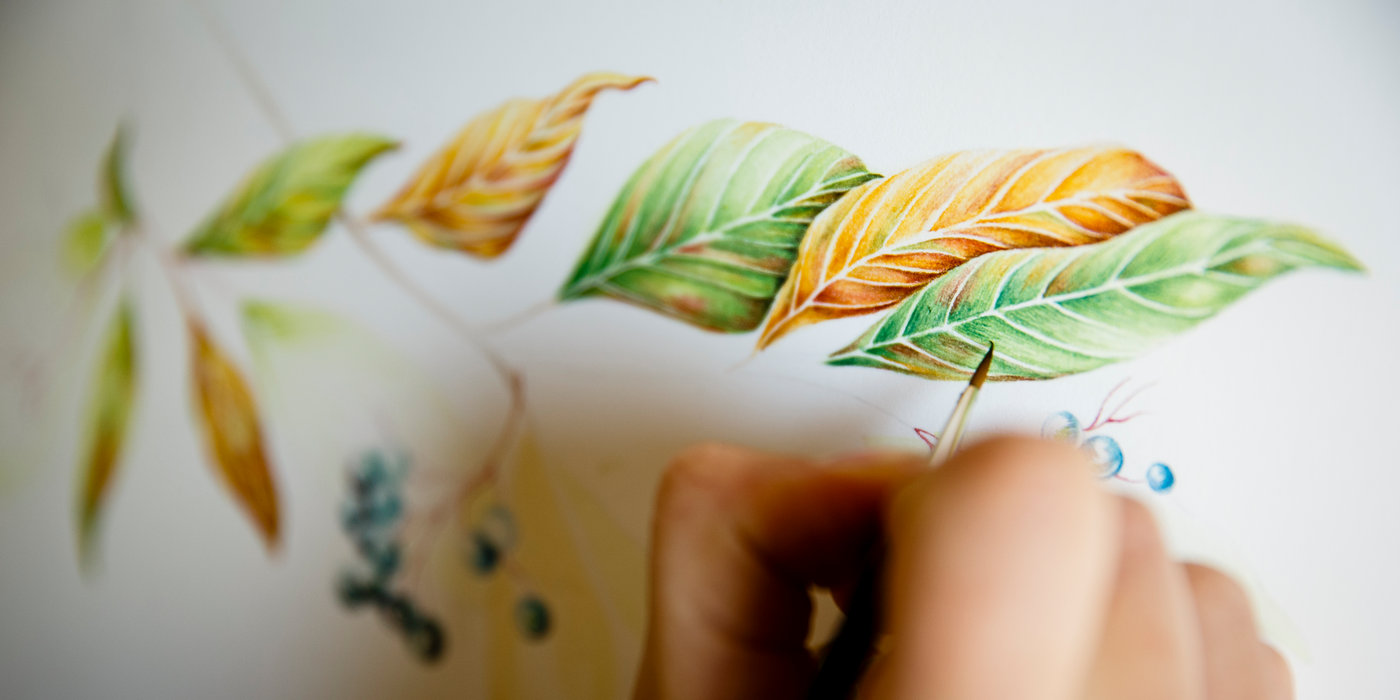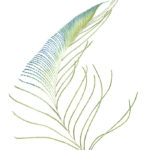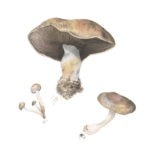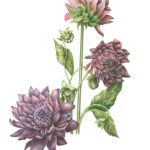In the middle of what many dubbed the worst winter ever, a botanical oasis resided in the O’Shaughnessy Educational Center gallery in the form of delicate works of watercolor, fused glass and ink by a collection of artists. Among the pieces was a brilliant purple dahlia that stood out from its placement on a blank brick wall. The artist who created it counts it among her favorites.
"I really like this composition," said St. Thomas sophomore Anna Rosenthal. "I feel like it captures the flower more with how radiant and bold it is." She would know. Rosenthal spent more than 40 hours examining the live plant while re-creating its likeness in watercolor.
Those 40-plus hours represent a process of many steps. As a botanical artist, it is important that Rosenthal thoroughly understand every nuance of her specimen. Before she begins a sketch she first studies the plant to learn where it grows, its habitat and color. Then she begins "building up" the colors through a meticulous layering process using watercolors. The result is a well-defined and sharp final image.
Any process that takes this much time requires a great deal of patience and persistence, traits that come along with maturity often reserved for seasoned artists. For Rosenthal, it’s something that comes naturally.
Curator and art history professor Shelly Nordtorp-Madson said Rosenthal’s work inspired the exhibition. "It is finely tuned and far above her age in its sophistication," she said. "Her sensitivity toward the details of each leaf and feather is moving."
Rosenthal has had a passion for nature for as long as she can remember. Her mother, Tami, shared her own love of the outdoors with Anna and her brother, fellow St. Thomas student Daniel Rosenthal. "I took them out on picnics all the time," she said. "We’d go exploring with a pad of paper. Anna was always drawing what she saw, even early on."
As a child, Rosenthal particularly enjoyed drawing animals. Her backyard was a source of curiosity and inspiration. When she discovered a caterpillar egg, she examined it daily until the day it began to hatch, according to Tami. When a caterpillar emerged, she named it Katie.
"Eventually, Katie became a monarch butterfly and Anna would study the details of its wings and go to paper to try to draw it," said Tami, who also remembers when her daughter asked for a photo of a moose. "She came back five hours later with this perfectly detailed drawing of just the moose’s head," she said. "Every single detail was there, every hair."
Because of her methodical level of focus and precision, the budding artist found it unfulfilling to work within the confines of the art classes at her school. "She started to get frustrated in about sixth grade," Tami said. Teachers we so impressed with her ability that she wasn’t getting the feedback she wanted. "They said, ‘this was good.’ But it doesn’t look like a leaf. I want it to look exactly like a leaf," Tami recalled her daughter venting.
Tami began researching options for art classes outside of school. She Googled every term she could think of related to nature and art and came across a class on how to draw trees. The class was only available to aspiring artists who were at least 18 years old. Her daughter was 14 at the time.
"Botanical art is intense," Tami said. "You have to have a lot of patience. Children usually aren’t mature enough to have that level of patience." She continued to search for a place where Anna could learn.
Tami, who has a background in elementary education, eventually found a match with the Minnesota School of Botanical Art. "They welcomed her and made her feel at home," Tami said, noting that despite her daughter’s age, staff at the school offered to "take Anna under their wing."
Her first classmates were four women in their 40s. But the age disparity didn’t matter to Anna. She had found a place where she could flourish and where she would be challenged. "Anna was happy when they would critique her so she knew what she could work on," Tami said.
The teenager impressed the staff and the school’s director, Marilyn Garber, who had never seen someone so young interested in botanical art.
The connection she made with Garber, an accomplished artist herself, opened many doors for Rosenthal as a burgeoning artist. By age 16, her first watercolor painting was exhibited at the Minnetonka Center for the Arts botanical art show. At 17, she had the opportunity to travel with a University of Minnesota biologist to Costa Rica, where as an intern she created 45 scientific illustrations of leaves for a field guide to be used in the Guanacaste National Park.
Rosenthal had discovered her niche. But amid the excitement of her budding talent, there also were difficulties.
When she was in high school, difficult circumstances resulted in struggles that often meant Anna and her mom having to move frequently. And there were times they did not always have a solid source of physical or financial security, which took a toll on them.
It was during those tough times that Rosenthal would return to the one thing that remained constant. "All the hard things I’ve gone through in my life – art has been the one thing that I can go to and just release everything," Rosenthal said. "I find so much peace in it. It’s therapeutic."
She also credits her faith in God as a true source of strength. "I know that my artistic abilities are a gift from him," she said. "He has proven faithful to work all things together for my good, providing for me every step of the way."
Her struggles helped Rosenthal develop a remarkable level of maturity. Her academic adviser, Art History Department chair Mark Stansbury-O’Donnell, recalled meeting her for the first time on an admissions visit. He was impressed with her sense of practicality that seemed beyond her years.
"It is unusual that a prospective student is so well-informed about the opportunities in the St. Thomas curriculum," he said. He was particularly struck by Rosenthal’s interest in creating an individualized major in scientific illustration, something he says there is a great need for. "It’s becoming harder and harder to find people who do it; it’s just not something people are training in."
To help pay for her education, Rosenthal has sold several of her pieces. According to Tami, her daughter is very conscious of how difficult it can be for artists to generate an income, particularly when they are just starting out. "She doesn’t want to accumulate a lot of student loan debt," Tami said.
As for her future, Rosenthal is hopeful that what she is learning as a college student will prepare her to launch a career as an artist. By pairing St. Thomas coursework with additional classes at St. Catherine University, she has declared a major in studio art, with an emphasis in graphic design. "I want to use college as an area where I can learn things that will help me later in life, or that I might not have the opportunity to do otherwise," she said, understanding that classes in business and digital image manipulation will give her skills that will allow her to work independently as a freelancer.
According to Stansbury-O’Donnell, the liberal arts approach is one that will serve Rosenthal well in her profession. "She’s got a direction, but she’s not limiting herself," he said, noting that her potential is enormous. "She’s able to create her own path. It may have twists and turns, but she will adapt and respond creatively."
Tami recently moved to a permanent home in a rural setting where Anna will have a dedicated room to work. Friends who live on nearby hobby farms have space for her to explore and create. "I feel like inspiration is everywhere around me. I love picking things to paint that are meaningful," Anna said.
For Tami, her daughter is the inspiration. "It’s wonderful when people can do what they love. She is good at making the world a beautiful place."
Read more from St. Thomas magazine.






